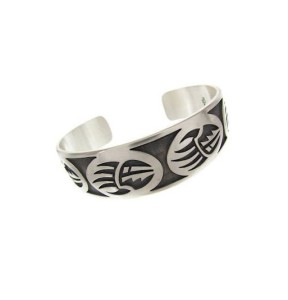
History of Hopi Indian Jewelry
Hopi Indians are known as peaceful and trace their ancestry to the Anasazi. These were the initial inhabitants of the prehistoric Four Corners. The population of the Hopi nation is approximately 8,500 and they border the Navajo reservation, which is located in the northeastern Arizona. The Hopi tradition homeland consists of three isolated mesas found in the northern Arizona. This ancient Oraibi pueblo is one of the villages that is continuously occupied in America and was build before 1150 A.D. the earliest Hopi Indian jewelry was made using shell, wood, seeds, stones and turquoise. Sileyatala of Walpi became the first Hopi Indian to gain knowledge about silver smith after visiting the Zuni in 1898. He was the first Mesa and taught other men this technique, which they used in making Hopi Indian jewelry.
The History of the Overlay Technique Used in Hopi Indian Jewelry
Nowadays, most Indian Hopi silversmiths use the overlay technique to make Hopi Indian jewelry. This technique was adopted in an effort to distinguish the Hopi Indian jewelry from those of other Native American tribes. The development of this technique commonly used in making Hopi Indian jewelry traces its roots to the Colton’s, who held annual shows at the Museum of Northern Arizona before 1940. The annual shows were interrupted during the years of the World War 2 and made a comeback in 1947.
The US government sponsored veteran silver smithing classes, which targeted soldiers returning from war. These veterans were provided with the appropriate tools, living expenses and training for 18 months. The Hopi Cooperative Guild was established in 1949 and helped in advancing the overlay technique that is used in making Hopi Indian jewelry. The Guild also provided the smiths with the necessary tools, training and silver to make Hopi Indian jewelry.
How the Silver Overlay Hopi Indian Jewelry is Made
Most Hopi Indian jewelry is made using the overlay technique that is created using two pieces of silver. A negative design is cut out from a sheet of silver and then soldered on another solid piece of silver. This overlay technique provides Hopi Indian jewelry with depth that makes them appear beautiful. After this, the negative cut out is matted with a wedge chisel. To create a contrasting background in Hopi Indian jewelry, this matted area is darkened with liver of sulpur to achieve the platinum gray or black surface .
The overlay in the Hopi Indian jewelry is buffed using a fine steel wool or buffing wheel to achieve that polished look. Polishing or brushing the Hopi Indian jewelry overlay makes them to stand out due to the contrasting dark background. Traditional Hopi Indian jewelry use traditional designs and symbols, such as bear claw, Kokopeli, cornstalk and man in the maze.
